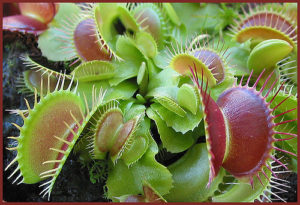Do plants compute?

Plants are no longer considered as insensitive and passive life forms. We even found novel means they communicate. What is more interesting is that several recent news tend to suggest some ability to count in plants.
The case of Venus flytraps
Venus flytrap by Jason
In this article, Jennifer Böhm et al. suggest that a carnivorous plant (Venus Flytrap Dionaea muscipula) is able to count the number of mechanical stimuli that trigger the production of digesting enzymes and sodium uptake modules.
The team asked the question as to “how many times trigger hairs (e.g. mechanosensors) have to be stimulated (e.g., how many APs are required) for the flytrap to recognize an encaged object as potential food, thus making it worthwhile activating the glands”.
What they found is the following:
One touch to a trigger hair sets the plant in a “ready” state. A second touch causes the trap to close around the prey. At five touches the plant begins to produce digestive enzymes and transporter molecules that take up nutrients.
It sounds like an algebraic summation that triggers different pathways.
Not yet impressed? Let me show you a more interesting computation in plants…
A more complex calculation…
A. thaliana by Alberto Salguero Quiles
Several years ago a team from the John Innes Centre found that Arabidopsis thaliana is able to perform some computations. In fact, this plant is able to have a perfect 5% of starch level after one night. Even when the night’s duration was artificially increased or decreased.
Actually, this well-known (but still unknown, in a way) plant can do arithmetic division to prevent starvation at night. The plant determines the remaining time before day then divide the starch level by this value to get the adequate velocity for consuming starch!
A novel perspective
Of course these calculations may not be conscious and are probably caused by a chemical imbalance. However, it opens really promising perspectives on the complexity of plants those are far more complex than initially thought.

